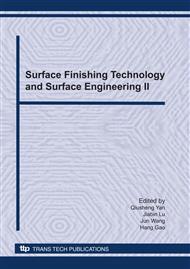p.64
p.69
p.73
p.79
p.84
p.90
p.96
p.102
p.107
The Contact Pressure Distribution and its Effects on the Magnetic Disc Substrate Surface Profiles in Chemical Mechanical Polishing
Abstract:
In order to obtain the contact pressure distribution between the hard disc substrate and the polishing pad and its effects on the profile of polished substrate surface, the elastic contact mechanical model and mathematical equations on the chemical mechanical polishing of the hard magnetic disc substrate are established, and also the relevant boundary conditions are put forward. The contact pressure distribution is calculated with FEM, the polishing experiments are carried out and the surface profiles of polished substrates are obtained. The study results show that the contact pressure distribution on the substrate surface is non-uniformity and the contact pressure in the substrate edge present biggish undulation. Choosing properly the Young’s modulus of the polishing pads and decreasing its Poisson’s ratios can make the uniform area of the contact pressure distribution enlarging and improve the flatness of polished substrate.
Info:
Periodical:
Pages:
84-89
Citation:
Online since:
October 2010
Authors:
Price:
Сopyright:
© 2010 Trans Tech Publications Ltd. All Rights Reserved
Share:
Citation:


